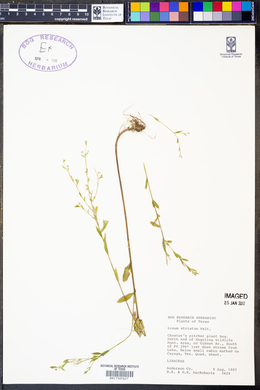Linum striatum
|
|
|
|
Family: Linaceae
Ridged Yellow Flax
[Linum diffusum] |
Perennial herb 20 cm - 1.2 m tall Stem: erect-ascending, one to several from base, unbranched below inflorescence, marked with parallel ridges. Leaves: opposite near base, becoming alternate above, mostly 25 to 50 below inflorescence, 1.5 - 3.5 cm long, 4 - 10 mm wide, elliptic to narrow and inversely egg-shaped. The leaf base continues down the stem (decurrent) to form strongly parallel ridges. Flowers: borne on a loose elongate inflorescence with slender spreading branches, numerous, with single flower stalks sharply angular and 1 - 4 mm long and five yellow petals 3 - 7 mm long. The five sepals are 1.5 - 3 mm long, lance-shaped to elliptic or egg-shaped with a pointed tip, with the inner sepals smaller and usually gland-toothed. Fruit: a capsule, about 2 mm across, depressed-spherical, splitting into ten sections and falling early. Similar species: Linum intercursum, Linum medium var. taxanum, Linum striatum, Linum sulcatum, and Linum virginianum have yellow petals and smaller fruit than the other Linum species in our region. Linum sulcatum is an annual with gland-toothed outer and inner sepals, styles that are united near the base, and leaves with a pair of glands at the base. The other three species lack a ridged stem. Additionally, L. intercursum has a narrow-tipped capsule, L. medium var. texanum has 30 to 150 leaves below its wide inflorescence, and L. virginianum has a wide inflorescence and a leaf base that continues down the stem but does not form a strong ridge. Flowering: mid June to late August Habitat and ecology: Sandy mucky meadows and flats near Lake Michigan. Occurence in the Chicago region: native Etymology: Linum is the Latin name for flax. Striatum means striped, referring to the ridged stems. Author: The Morton Arboretum Glabrous perennial 3-9 dm; stems 1-several from the base, erect-ascending, simple below the infl, prominently ridged-striate above; lvs mostly 25-50 below the infl, thin, elliptic to oblanceolate or obovate, the larger ones 1.5-3.5 cm נ4-10 mm, the lower opposite, the upper often alternate; infl ±elongate-paniculiform, with slender, spreading branches; pedicels sharply angular, 1-4 mm; sep lanceolate to ovate, acute, 1.5-3 mm, entire or the inner with a few tiny marginal glands; pet yellow, 3-5 mm; fr depressed-globose, scarcely 2 mm, pale, splitting freely into 10 mericarps, shattering and falling; false septa nearly complete, glabrous, as also the true septa; 2n=36. Damp or wet woods, swamps, and bogs; Mass. to n. Fla., w. to Mich., se. Mo., and e. Tex. June, July. (Cathartolinum s.) Gleason, Henry A. & Cronquist, Arthur J. 1991. Manual of vascular plants of northeastern United States and adjacent Canada. lxxv + 910 pp. ©The New York Botanical Garden. All rights reserved. Used by permission. From Flora of Indiana (1940) by Charles C. Deam Our specimens are from mediacid, hard, white clay soil in low, beech and sweet gum woods, one from a wooded slope, and one from the border of an interdunal flat. Rare. .…… Indiana Coefficient of Conservatism: C = 5 Wetland Indicator Status: FACW |









































































